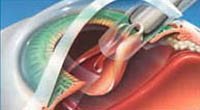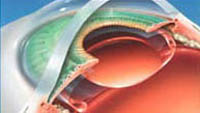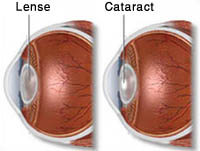Cataract
Cataract surgery is the most performed surgery in the world and the surgery with the highest success rate (over 97 percent)1. However, it is still surgery and knowing some basic things about the recovery period will help both patients and caregivers adjust.
What Are Cataracts?
A cataract is a clouding of the natural lens inside the eye. Cataracts are the leading cause of treatable blindness in all areas of the world, especially in adults 55 and older.
Contrary to popular belief, a cataract is not a "film" over the eye. Rather it is a gradual thickening of the lens that causes the lens to become so clouded that light is either distorted or cannot reach the back of the eye (the retina) for transmission to the brain. When left untreated, cataracts will cause blindness.
What Causes Cataracts?
In general, there are two main causes of cataracts: we can acquire them or we can be born with them. We can acquire cataracts via the natural aging process, trauma, diabetes, or use of some types of medications.
What Are the Symptoms of Cataracts?
The following can all be symptoms of cataracts:
- Blurry or dim vision.
- Colors appearing faded.
- Poor night vision.
- Halos appearing around lights.
- Sensitivity to bright lights.
Age-related cataracts develop very slowly and painlessly. In fact, we may not even realize that our vision is changing until we find ourselves going to the eye doctor seeking a change in our eyeglass or contact lens prescription.
What Are the Options for Treating Cataracts?
Once a cataract has formed, surgical removal of the clouded lens is the only way to restore lost vision. But a cataract can progress very slowly, and, early-stage symptoms can often be addressed with stronger glasses or contacts, brighter lighting, or the use of a magnifying glass. In situations where a cataract exists in combination with one or more diseases or conditions, your doctor also may recommend surgery even if your vision is only mildly impaired. This could happen if your cataract is interfering with the examination or treatment of other parts of the eye.


An intraocular lens, or IOL, is an artificial lens made of plastic, silicone or acrylic that performs the function of the eye's natural lens. Most of today's IOLs are less than a quarter of an inch in diameter and soft enough to be folded so they can be placed into the eye through a very small incision.
Types of IOLs include:
- Monofocal lenses correct vision at a set distance but require the wearing of glasses for close-up tasks.
- Multifocal lenses correct vision at all ranges (near, intermediate and distance).
- Accommodative lenses are designed to correct vision at all ranges by responding to the eye's muscles.
- Toric lenses correct astigmatism.
- Aspheric, correcting spherical aberrations (a change in curvature between the center and edge of the pupil) which results in the blurring of images.
- Light-filtering. Many IOLs filter potentially harmful UV and high energy blue light rays, both of which are present in natural and artificial light.
Immediately to 24 Hours After Surgery
After surgery, you will not be allowed to drive for 24 hours, so someone else will need to drive you home. Either before or immediately after surgery, you should have your prescriptions filled at the pharmacy. Use your medications exactly as your doctor has recommended.
Stinging, burning, and a slight grittiness in the eye are normal following surgery; do not rub or put pressure on your eye. If you have any discharge issuing from your eye, use a damp, warm washcloth to wipe the discharge away. Your doctor will tell you what is normal to expect.
On the day of the surgery, your doctor will probably advise that it is okay to resume light activities such as reading, writing, watching TV, and walking. You may be tempted to do more, since your vision will most likely be significantly improved, but you have just had surgery, so take it easy.
You may take a shower or a bath, but keep your eyes closed.
